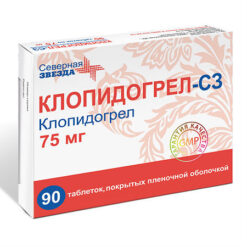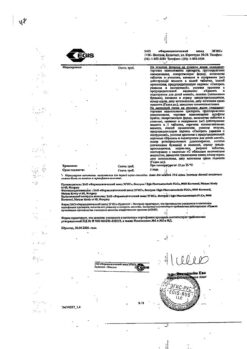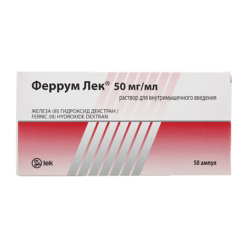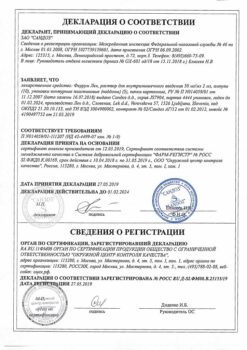No products in the cart.
Clopidogrel-SZ, 75 mg 30 pcs.
€1.00
Out of stock
(E-mail when Stock is available)
Description
Antiplatelet. Clopidogrel is a prodrug, one of the active metabolites of which is an inhibitor of platelet aggregation. The active metabolite of clopidogrel selectively inhibits the binding of adenosine diphosphate (ADP) to the P2Y12 receptor of platelets and the subsequent ADP-mediated activation of the GPIIb/IIIa complex, leading to suppression of platelet aggregation.
The irreversible binding ensures that platelets remain immune to ADP stimulation for the remainder of their lives (approximately 7-10 days), and recovery of normal platelet function occurs at a rate consistent with the rate of platelet renewal.
The aggregation of platelets caused by agonists other than ADP is also inhibited by blocking enhanced platelet activation by the released ADP. Because formation of the active metabolite occurs via P450 system isoenzymes, some of which may be polymorphic or may be inhibited by other drugs, adequate platelet suppression is not possible in all patients.
Clopidogrel is able to prevent the development of atherothrombosis in any localization of atherosclerotic vascular lesions, in particular in lesions of the cerebral, coronary or peripheral arteries.
On daily use of clopidogrel at a dose of 75 mg from the first day of administration a significant suppression of ADP-induced platelet aggregation is noted, which gradually increases over 3-7 days and then reaches a constant level (when equilibrium is reached).
In the equilibrium state platelet aggregation is suppressed by an average of 40-60%. After stopping clopidogrel administration, platelet aggregation and bleeding time gradually return to baseline within an average of 5 days.
Indications
Indications
Prevention of atherothrombotic events in patients who have suffered a myocardial infarction (with a duration of several days to 35 days), ischemic stroke (with a duration of 7 days to 6 months) or have been diagnosed with occlusive disease of peripheral arteries.
Prevention of atherothrombotic events (in combination with acetylsalicylic acid) in patients with acute coronary syndrome:
– without ST segment elevation (unstable angina or non-Q wave myocardial infarction), including patients who underwent stenting during percutaneous coronary intervention;
– with ST segment elevation (acute myocardial infarction) with drug treatment and the possibility of thrombolysis.
Pharmacological effect
Pharmacological effect
Antiplatelet agent. Clopidogrel is a prodrug, one of the active metabolites of which is an inhibitor of platelet aggregation. The active metabolite of clopidogrel selectively inhibits the binding of adenosine diphosphate (ADP) to the platelet P2Y12 receptor and subsequent ADP-mediated activation of the GPIIb/IIIa complex, leading to suppression of platelet aggregation.
Due to irreversible binding, platelets remain immune to ADP stimulation for the remainder of their life (approximately 7-10 days), and restoration of normal platelet function occurs at a rate consistent with platelet turnover.
Platelet aggregation induced by agonists other than ADP is also inhibited by blocking enhanced platelet activation by released ADP. Because the formation of the active metabolite occurs with the help of isoenzymes of the P450 system, some of which may differ in polymorphism or may be inhibited by other drugs; not all patients have adequate platelet suppression.
Clopidogrel is able to prevent the development of atherothrombosis in any localization of atherosclerotic vascular lesions, in particular in lesions of the cerebral, coronary or peripheral arteries.
With daily use of clopidogrel at a dose of 75 mg, from the first day of administration there is a significant suppression of ADP-induced platelet aggregation, which gradually increases over 3-7 days and then reaches a constant level (when an equilibrium state is reached).
At steady state, platelet aggregation is suppressed by an average of 40-60%. After discontinuation of clopidogrel, platelet aggregation and bleeding time gradually returned to baseline levels within an average of 5 days.
Special instructions
Special instructions
When treating with Clopidogrel-SZ, especially during the first weeks of therapy and/or after invasive cardiac procedures/surgery, it is necessary to carefully monitor patients to exclude signs of bleeding, incl. and hidden.
Due to the risk of bleeding and hematological undesirable effects, if clinical symptoms suspicious for bleeding appear during treatment, you should urgently do a clinical blood test, determine APTT, platelet count, indicators of platelet functional activity and conduct other necessary studies.
Clopidogrel-SZ, as well as other antiplatelet drugs, should be used with caution in patients who have an increased risk of bleeding associated with trauma, surgery or other pathological conditions, as well as in patients receiving acetylsalicylic acid, NSAIDs, incl. COX-2 inhibitors, heparin or glycoprotein IIb/IIIa inhibitors.
The combined use of clopidogrel with warfarin may increase the intensity of bleeding, therefore, with the exception of very rare clinical situations (such as the presence of a floating thrombus in the left ventricle, stenting in patients with atrial fibrillation), the combined use of clopidogrel and warfarin is not recommended.
If the patient is undergoing a planned surgical intervention, and there is no need for an antiplatelet effect, then 7 days before surgery, the drug Clopidogrel-SZ should be stopped.
Clopidogrel prolongs bleeding time and should be used with caution in patients with diseases predisposing to the development of bleeding (especially gastrointestinal and intraocular).
Patients should be warned that when using Clopidogrel-SZ (alone or in combination with acetylsalicylic acid) it may take longer to stop bleeding, and that if they experience unusual bleeding (in location or duration) they should inform their doctor. Before any upcoming surgery and before starting any new drug, patients should tell their doctor (including dentist) that they are taking Clopidogrel-SZ.
Very rarely, after using the drug Clopidogrel-SZ (sometimes even for a short time), there have been cases of development of thrombocytopenic thrombohemolytic purpura (THP), which is characterized by thrombocytopenia and microangiopathic hemolytic anemia, accompanied by neurological disorders, renal dysfunction and fever. THP is a potentially life-threatening condition that requires immediate treatment, including plasmapheresis.
During treatment, it is necessary to monitor the functional activity of the liver. In case of severe liver dysfunction, one should remember the risk of developing hemorrhagic diathesis.
Taking the drug Clopidogrel-SZ is not recommended for acute stroke less than 7 days old (since there is no data on its use in this condition).
Clopidogrel-SZ should not be taken by patients with rare hereditary galactose intolerance, lactase deficiency and glucose-galactose malabsorption syndrome.
Impact on the ability to drive vehicles and operate machinery
Clopidogrel-SZ does not have a significant effect on the ability required to drive vehicles or operate machinery.
Active ingredient
Active ingredient
Clopidogrel
Composition
Composition
1 tab. – clopidogrel (in the form of hydrogen sulfate or bisulfate) 75 mg.
Pregnancy
Pregnancy
As a precautionary measure, the use of clopidogrel during pregnancy is not recommended due to the lack of clinical data on its use in pregnant women, although animal studies have shown no direct or indirect adverse effects on pregnancy, embryonic development, childbirth and postnatal development.
Contraindications
Contraindications
– severe liver failure;
– acute bleeding (for example, bleeding from a peptic ulcer or intracranial hemorrhage);
– rare hereditary lactose intolerance, lactase deficiency and glucose-galactose malabsorption;
– pregnancy;
– lactation period;
– children and adolescents under 18 years of age (safety and effectiveness of use have not been established);
– hypersensitivity to clopidogrel or any of the excipients of the drug.
With caution:
– moderate liver failure, which may predispose to bleeding (limited clinical experience);
– renal failure (limited clinical experience);
— trauma, surgical interventions;
– diseases in which there is a predisposition to the development of bleeding (especially gastrointestinal or intraocular);
– simultaneous use of non-steroidal anti-inflammatory drugs, incl. selective COX-2 inhibitors;
– simultaneous use of warfarin, heparin, glycoprotein IIb/IIIa inhibitors;
– in patients with a genetically determined decrease in the function of the CYP2C19 isoenzyme in recommended doses (there is literature data indicating that patients with a genetically determined decrease in the function of the CYP2C19 isoenzyme are exposed to less systemic exposure to the active metabolite of clopidogrel and have a less pronounced effect of the drug, in addition, they may experience a higher incidence of cardiovascular complications after myocardial infarction compared to patients with normal function isoenzyme CYP2C19).
Side Effects
Side Effects
Classification of the incidence of side effects (WHO): often (>1/100 and 1/1000 and 1/10,000 and <1/1000), very rare (<1/10,000).
From the central and peripheral nervous system: infrequently – headache, dizziness and paresthesia; rarely – vertigo; very rarely – disturbance of taste.
Mental disorders: very rarely – confusion, hallucinations.
From the cardiovascular system: very rarely – vasculitis, marked decrease in blood pressure, intracranial hemorrhage, ocular hemorrhage (conjunctival, in the tissue and retina), hematoma, nosebleeds, bleeding from the respiratory tract, gastrointestinal bleeding, fatal retroperitoneal hemorrhage, hemorrhages in the muscles and joints, hematuria.
From the respiratory system: very rarely – bronchospasm, interstitial pneumonitis.
From the digestive system: often – diarrhea, abdominal pain, dyspepsia; uncommon – gastric and duodenal ulcers, gastritis, vomiting, nausea, constipation, flatulence; very rarely – pancreatitis, colitis (including ulcerative or lymphocytic colitis), stomatitis, acute liver failure, hepatitis.
From the urinary system: very rarely – glomerulonephritis.
From the blood coagulation system: infrequently – prolongation of bleeding time.
From the hematopoietic system: infrequently – thrombocytopenia, leukopenia, neutropenia and eosinophilia; very rarely – thrombocytopenic thrombohemolytic purpura, severe thrombocytopenia (platelet count ≤30×109/l), agranulocytosis, granulocytopenia, aplastic anemia (pancytopenia), anemia.
From the skin and subcutaneous tissues: infrequently – skin rash and itching; very rarely – angioedema, urticaria, erythematous rash (associated with clopidogrel or acetylsalicylic acid); very rarely – bullous dermatitis (erythema multiforme, Stevens-Johnson syndrome, toxic epidermal necrolysis), eczema and lichen planus.
From the musculoskeletal system: very rarely – arthralgia, arthritis, myalgia.
From the immune system: very rarely – anaphylactoid reactions, serum sickness.
From the laboratory parameters: very rarely – changes in liver tests, increase in serum creatinine concentration.
Other: very rarely – fever.
Interaction
Interaction
Warfarin
Concomitant use with clopidogrel may increase the intensity of bleeding, so the use of this combination is not recommended.
IIb/IIIa receptor blockers
The use of IIb/IIIa receptor blockers in combination with clopidogrel requires caution in patients with an increased risk of bleeding (in cases of trauma and surgery or other pathological conditions).
Acetylsalicylic acid
Acetylsalicylic acid does not change the effect of clopidogrel, which inhibits ADP-induced platelet aggregation, but clopidogrel potentiates the effect of acetylsalicylic acid on collagen-induced platelet aggregation. However, simultaneous administration of acetylsalicylic acid as an antipyretic agent with clopidogrel, 500 mg 2 times a day for 1 day, did not cause a significant increase in the bleeding time caused by taking clopidogrel.
There may be a pharmacodynamic interaction between clopidogrel and acetylsalicylic acid, which leads to an increased risk of bleeding. Therefore, caution should be exercised when using them simultaneously, although in clinical studies patients received combination therapy with clopidogrel and acetylsalicylic acid for up to one year.
Heparin
According to a clinical study conducted with healthy volunteers, when taking clopidogrel, no change in the dose of heparin was required and its anticoagulant effect did not change. Concomitant use of heparin did not change the antiplatelet effect of clopidogrel. There may be a pharmacodynamic interaction between clopidogrel and heparin, which may increase the risk of bleeding, so the simultaneous use of these drugs requires caution.
Thrombolytics
The safety of simultaneous use of clopidogrel, fibrin-specific or non-fibrin-specific thrombolytic drugs and heparin has been studied in patients with acute myocardial infarction. The incidence of clinically significant bleeding was similar to that observed with the simultaneous use of thrombolytic agents and heparin with acetylsalicylic acid.
NSAIDs
In a clinical study conducted in healthy volunteers, concomitant use of clopidogrel and naproxen increased occult gastrointestinal blood loss. However, due to the lack of interaction studies between clopidogrel and other NSAIDs, it is currently unknown whether there is an increased risk of gastrointestinal bleeding when clopidogrel is taken with other NSAIDs. Therefore, the prescription of NSAIDs, incl. selective COX-2 inhibitors should be used with caution in combination with clopidogrel.
Other combination therapy
Because Clopidogrel is metabolized to the formation of its active metabolite in part by the CYP2C19 isoenzyme; the use of drugs that inhibit this system may lead to a decrease in the concentration of the active metabolite of clopidogrel and a decrease in its clinical effectiveness. Concomitant use of drugs that inhibit the CYP2C19 isoenzyme (for example, omeprazole) is not recommended.
A number of clinical studies have been conducted with clopidogrel and other concomitantly prescribed drugs to study possible pharmacodynamic and pharmacokinetic interactions, which showed that:
– when clopidogrel was used together with atenolol, nifedipine, or with both drugs at the same time, no clinically significant pharmacodynamic interaction was observed;
– simultaneous use of phenobarbital, cimetidine and estrogens did not have a significant effect on the pharmacodynamics of clopidogrel;
– the pharmacokinetic parameters of digoxin and theophylline did not change when they were used simultaneously with clopidogrel;
– antacids did not reduce the absorption of clopidogrel;
– Phenytoin and tolbutamide can be safely used concomitantly with clopidogrel, although data obtained from studies with human liver microsomes indicate that the carboxyl metabolite of clopidogrel may inhibit the activity of the CYP2C9 isoenzyme, which may lead to increased plasma concentrations of some drugs (phenytoin, tolbutamide and some NSAIDs) that are metabolized by isoenzyme CYP2C9;
– ACE inhibitors, diuretics, beta-blockers, slow calcium channel blockers, hypoglycemic agents (including insulin), lipid-lowering agents, antiepileptic drugs, HRT and GP IIb/IIIa receptor blockers – no clinically significant adverse interactions were identified in clinical studies.
Overdose
Overdose
Symptoms: prolongation of bleeding time with subsequent complications in the form of bleeding.
Treatment: stop bleeding, platelet transfusion. Antidote unknown.
Recommendations for use
Recommendations for use
Adults and elderly patients with normal CYP2C19 isoenzyme activity
Clopidogrel-SZ should be taken orally, regardless of meals.
Myocardial infarction, ischemic stroke and diagnosed peripheral arterial occlusive disease
The drug is taken 75 mg 1 time/day.
In patients with myocardial infarction (MI), treatment can begin from the first days to the 35th day of MI, and in patients with ischemic stroke (IS), from 7 days to 6 months after IS.
Acute coronary syndrome without ST segment elevation (unstable angina, non-Q wave myocardial infarction)
Treatment with Clopidogrel-SZ should be started with a single loading dose of 300 mg, and then continued at a dose of 75 mg 1 time / day (in combination with acetylsalicylic acid as an antiplatelet agent in doses of 75-325 mg / day). Since the use of acetylsalicylic acid in higher doses is associated with an increased risk of bleeding, the recommended dose of acetylsalicylic acid for this indication should not exceed 100 mg. The maximum therapeutic effect is observed by the third month of treatment. The course of treatment is up to 1 year.
Acute coronary syndrome with ST segment elevation (acute myocardial infarction with ST segment elevation)
Clopidogrel is prescribed at a dose of 75 mg 1 time / day with an initial single dose of a loading dose in combination with acetylsalicylic acid as an antiplatelet agent and thrombolytics (or without thrombolytics). Combination therapy is started as soon as possible after the onset of symptoms and continued for at least 4 weeks. In patients over 75 years of age, treatment with Clopidogrel-SZ should be started without taking a loading dose.
Patients with a genetically determined decrease in the function of the CYP2C19 isoenzyme
Weakening of metabolism by the CYP2C19 isoenzyme may lead to a decrease in the antiplatelet effect of clopidogrel. The optimal dosage regimen for patients with impaired metabolism by the CYP2C19 isoenzyme has not yet been established.
After repeated doses of Clopidogrel-SZ at a dose of 75 mg/day in patients with severe kidney damage (creatinine clearance from 5 to 15 ml/min), the inhibition of ADP-induced platelet aggregation (25%) was lower compared to that in healthy volunteers, however, the prolongation of bleeding time was similar to that in healthy volunteers receiving Clopidogrel-SZ at a dose of 75 mg/day. In addition, all patients had good tolerability of the drug.
After daily administration of Clopidogrel-SZ at a dose of 75 mg for 10 days in patients with severe liver damage, the inhibition of ADP-induced platelet aggregation was similar to that in healthy volunteers. The mean bleeding time was also comparable in both groups.
The prevalence of alleles of the CYP2C19 isoenzyme genes responsible for intermediate and reduced metabolism of clopidogrel to its active metabolite varies among representatives of different ethnic groups. There are only limited data in Mongoloid populations to assess the effect of CYP2C19 genotype on clinical outcome events.
Storage conditions
Storage conditions
The drug should be stored out of the reach of children, in a dry, dark place at a temperature not exceeding 25°C.
Shelf life
Shelf life
3 years.
Manufacturer
Manufacturer
North Star NAO, Russia
Additional information
| Shelf life | 3 years. |
|---|---|
| Conditions of storage | The drug should be kept out of reach of children, dry and protected from light at a temperature not exceeding 25 ° C. |
| Manufacturer | North Star NAO, Russia |
| Medication form | pills |
| Brand | North Star NAO |
Other forms…
Related products
Buy Clopidogrel-SZ, 75 mg 30 pcs. with delivery to USA, UK, Europe and over 120 other countries.


















